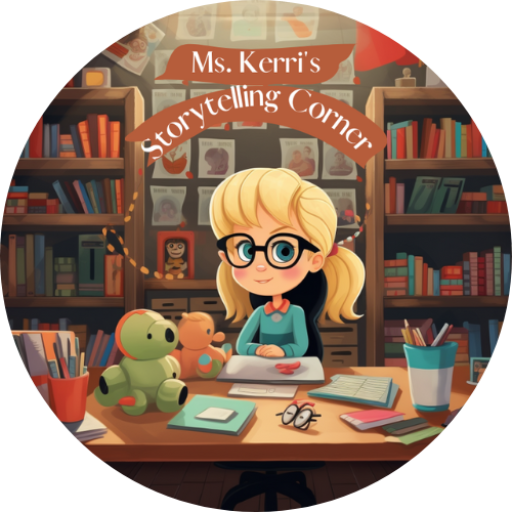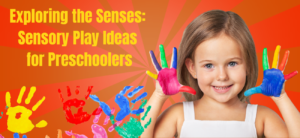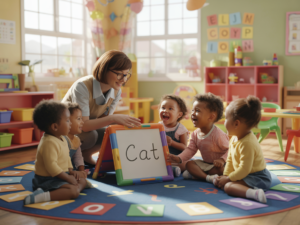In order to foster literacy skills from an early age, it is crucial to engage babies and toddlers in language-rich interactions. These interactions not only help build strong foundations for literacy but also enhance their overall language development. This article explores the importance of language-rich interactions and provides practical strategies for parents and caregivers to incorporate them into daily routines. By implementing these techniques, parents can create a language-rich environment that promotes language acquisition and supports the cognitive development of their children.
Key Takeaways
- Engage in conversations with babies and toddlers to enhance their language skills.
- Create a language-rich environment by surrounding children with books, visuals, and props.
- Choose age-appropriate books that are interactive and engaging for babies and toddlers.
- Incorporate sensory play and pretend play to promote language development.
- Use music and rhymes to introduce new vocabulary and enhance language skills.
Why Language-Rich Interactions Matter

Building Strong Foundations for Literacy
Building strong foundations for literacy is essential for the development of language skills in babies and toddlers. Reading aloud plays a crucial role in early childhood education, enhancing literacy skills and introducing children to imagination and wonder. Combining phonics learning with moral lessons through read-alouds can engage children in learning while instilling important values. Selecting engaging and ethical read-aloud stories can promote literacy and inspire kindness and compassion in children. It is important to create a language-rich environment that encourages interaction and conversation. Talking to babies and toddlers throughout the day helps them develop vocabulary, comprehension, and communication skills. Engaging in conversations with them, even if they can’t respond yet, helps build their understanding of language and encourages them to communicate when they are ready. Language-rich interactions provide the foundation for language development and future literacy success.
The Power of Conversations
Conversations are not just a way to communicate with babies and toddlers, they are a powerful tool for their language development. When you engage in conversations with young children, you are not only teaching them words and sentences, but you are also fostering open communication and social interaction. Storytelling is a great way to have meaningful conversations with little ones. It not only shapes young minds by nurturing relationships, but it also promotes diversity and empathy. Storytelling activates multiple brain regions, enhances language and literacy skills, stimulates imagination and problem-solving, and builds empathy and emotional intelligence.
Creating a Language-Rich Environment
Creating a language-rich environment is essential for fostering early literacy skills in babies and toddlers. Language-rich interactions provide numerous benefits for language development, cognitive growth, and social-emotional development. By surrounding children with a variety of words, sounds, and experiences, we can help them build a strong foundation for literacy.
Engaging Babies and Toddlers in Reading

Choosing Age-Appropriate Books
Selecting age-appropriate books for children is crucial for their cognitive and emotional development. Tailoring the reading experience fosters comprehension, engagement, and a lifelong love of reading. When choosing books for babies and toddlers, it’s important to consider their developmental stage and interests. Books with simple and repetitive text are great for young children as they help build vocabulary and language skills. Look for books with bright and colorful illustrations that capture their attention. Interactive books that have touch-and-feel elements or flaps to lift can also enhance their sensory experience and keep them engaged.
Interactive Storytelling
Interactive storytelling is a powerful tool for engaging babies and toddlers in language-rich interactions. It goes beyond simply reading a story aloud; it involves actively involving the child in the storytelling process. By using gestures, facial expressions, and different voices, caregivers can bring the story to life and capture the child’s attention.
One effective technique is to pause at key moments in the story and ask the child questions. This encourages them to think critically, make predictions, and engage in conversation. For example, while reading a book about animals, you can ask, ‘What sound does a cow make?’ or ‘Can you find the cat in the picture?’
Another way to make storytelling interactive is by using props and visuals. This can include using puppets, stuffed animals, or even simple objects like a ball or a spoon. These props can help to reinforce the story and make it more engaging for the child.
Remember, the goal of interactive storytelling is to create a language-rich environment where babies and toddlers can develop their vocabulary, comprehension, and critical thinking skills. So, don’t be afraid to get creative and have fun with it!
Using Props and Visuals
When engaging babies and toddlers in reading, using props and visuals can enhance their learning experience. Props such as puppets, stuffed animals, or objects related to the story can make the story come alive and capture their attention. Visuals, such as colorful illustrations or pictures, can help them understand the story better and stimulate their imagination.
Incorporating props and visuals during storytelling can also encourage interaction and participation. Change your voice for different characters in the story and pause to ask questions or discuss thoughts. This not only makes the reading more engaging but also promotes critical thinking and language development.
To create a cozy reading nook, you can set up a comfortable space with cushions or blankets where you and your child can sit together and enjoy the story. Selecting diverse books that represent different cultures, languages, and experiences can broaden their understanding of the world and foster empathy.
In addition to traditional books, technology can also be utilized to enhance the reading experience. Audiobooks and dual-screening can provide a multi-sensory experience and expose children to different forms of storytelling.
Promoting Language Development Through Play

Sensory Play and Language
Sensory play is a fantastic way to engage babies and toddlers in language development. By incorporating different textures, smells, and sounds into playtime, children are not only having fun but also building important language skills. Exploring different materials like sand, water, and playdough can help children develop vocabulary as they describe what they see, feel, and hear.
In addition to vocabulary development, sensory play also promotes sensory integration and cognitive development. When children engage their senses, they are making connections in their brain and strengthening neural pathways. This helps them make sense of the world around them and develop important cognitive skills.
To incorporate sensory play into your daily routine, you can create a sensory bin filled with different materials for your child to explore. You can also set up sensory stations with different textures and objects for them to touch and manipulate. Remember to supervise your child during sensory play to ensure their safety and provide guidance when needed.
Here are some ideas for sensory play activities:
- Sensory bins filled with rice, beans, or pasta
- Water play with cups, funnels, and sponges
- Playdough with different scents and colors
- Sensory bags filled with gel, glitter, or beads
By incorporating sensory play into your child’s daily routine, you are not only providing them with a fun and engaging activity but also fostering their language development and cognitive skills.
Pretend Play and Vocabulary
Pretend play is not just fun, it’s also a powerful tool for building vocabulary. When children engage in imaginative play, they create scenarios and act out different roles, which requires them to use a wide range of words and phrases. Encourage your little one to pretend to be a doctor, a chef, or a superhero, and watch their vocabulary expand!
To enhance the language-rich experience during pretend play, you can:
Introduce new words: Use descriptive language to describe the pretend objects and actions. For example, instead of saying ‘Here’s a toy car,’ you can say ‘Here’s a shiny red sports car.’
Ask open-ended questions: Prompt your child to think and respond creatively by asking questions like ‘What do you think will happen next?’ or ‘How would you solve this problem?’
Provide props and costumes: Props and costumes can make pretend play more immersive and engaging. They can also introduce new vocabulary words related to the theme of play.
Remember, pretend play is not just about having fun, it’s about fostering language development and expanding your child’s vocabulary in a natural and enjoyable way.
Music and Rhyme Time
Music and rhyme play a crucial role in language development for babies and toddlers. Singing songs and reciting rhymes not only captivate their attention but also help them develop important pre-literacy skills. When babies and toddlers listen to music and participate in rhythmic activities, they are exposed to the rhythm and cadence of language, which lays the foundation for future reading and speaking abilities.
Incorporating music and rhyme time into daily routines can be a fun and interactive way to promote language development. Here are some ideas to make the most of this language-rich activity:
- Nursery Rhymes: Sing traditional nursery rhymes like ‘Twinkle, Twinkle, Little Star’ or ‘Row, Row, Row Your Boat’. These rhymes have repetitive patterns and simple melodies that make it easier for babies and toddlers to follow along and join in.
- Action Songs: Choose songs that involve actions, such as ‘Head, Shoulders, Knees, and Toes’ or ‘The Wheels on the Bus’. Encourage babies and toddlers to mimic the actions while singing along.
- Rhyme Time: Introduce simple rhymes that focus on specific sounds or word families. For example, ‘Pat-a-Cake’ or ‘Hickory Dickory Dock’ can help babies and toddlers become familiar with the sounds of words.
By incorporating music and rhyme time into daily routines, parents and caregivers can create a language-rich environment that supports babies and toddlers in their language development journey.
Incorporating Language-Rich Activities in Daily Routines

Mealtime Conversations
Transform the clink and clatter of mealtime into a symphony of language learning. It’s the perfect time to chat, listen, and sprinkle in new words like a dash of seasoning. Engagement is key; face your little one, make eye contact, and let the conversation flow naturally.
- Ask about their day, even if ‘their day’ is mostly babble and giggles.
- Describe the colors, shapes, and textures on the plate.
- Wonder aloud about where food comes from or how it grows.
Tip: Keep questions open-ended to encourage more than just ‘yes’ or ‘no’ answers. ‘What do you think this tastes like?’ is far more stimulating than ‘Do you like it?’.
Remember, it’s not just about the words; it’s about the rhythm and dance of dialogue. Your attentive back-and-forth is a powerful tool in nurturing a budding conversationalist. So, let’s turn mealtime into a feast for the mind as well as the tummy!
Bath Time Language Fun
Bath time is not just for getting clean, it’s also a great opportunity to engage in language-rich interactions with your baby or toddler. Exploring children’s books with rich language can enhance their vocabulary and language skills. You can read aloud to them while they play in the water, using expressive voices and gestures to make the story come alive. Ms. Kerri shares delightful stories and invites young viewers to be part of the storytelling journey. Encourage your child to participate by pointing to pictures, making sounds, or even splashing along with the story.
Language Games During Playtime
Language games are a fun and interactive way to promote language development in babies and toddlers. These games not only engage children in playful activities but also help them learn new words, improve their vocabulary, and enhance their communication skills. Encourage reading as a social activity, use drama and expression while reading, encourage participation and repetition, and establish regular read aloud routines to foster a love for reading. Here are some language games that you can incorporate into playtime:
Incorporating language-rich activities in daily routines is a great way to enhance language development in children. By integrating language learning into everyday activities such as mealtime, bath time, and playtime, children are exposed to a variety of vocabulary, grammar, and communication skills. Ms. Kerri’s Story Telling Corner is a website dedicated to providing resources and ideas for incorporating language-rich activities into daily routines. Visit the website to discover fun and engaging activities that will help your child develop their language skills while having a great time. Click here to explore Ms. Kerri’s Story Telling Corner!
In Conclusion
Fostering literacy from day one is crucial for the development of babies and toddlers. By engaging in language-rich interactions, parents and caregivers can create a nurturing environment that helps children thrive. Reading, talking, and singing to babies not only enhances their language skills, but also strengthens the parent-child bond. It is never too early to start building a strong foundation for literacy. So, let’s embark on this exciting journey of language exploration with our little ones and watch them flourish!
Frequently Asked Questions
Why are language-rich interactions important for babies and toddlers?
Language-rich interactions are important for babies and toddlers because they help build strong foundations for literacy. These interactions provide opportunities for language development, vocabulary expansion, and cognitive growth.
How can I create a language-rich environment for my baby or toddler?
To create a language-rich environment for your baby or toddler, you can talk to them frequently, read books together, sing songs, and engage in interactive conversations. It is also helpful to provide a variety of language-rich materials and experiences.
What types of books are age-appropriate for babies and toddlers?
Age-appropriate books for babies and toddlers are typically board books with simple, colorful illustrations and sturdy pages. These books often have repetitive text, rhymes, and interactive elements that engage young children.
How can I make storytelling interactive for my baby or toddler?
To make storytelling interactive for your baby or toddler, you can use different voices for characters, ask questions about the story, encourage them to point to pictures, and invite them to participate in actions or movements related to the story.
What are some examples of sensory play activities that promote language development?
Examples of sensory play activities that promote language development include playing with textured objects, exploring different smells and tastes, and engaging in activities that involve the senses of touch, sight, and sound.
How can I incorporate language-rich activities into daily routines like mealtime and bath time?
To incorporate language-rich activities into daily routines like mealtime and bath time, you can engage in conversations with your baby or toddler, describe what you are doing, sing songs, and introduce new vocabulary related to the activities.


Ms. Kerri’s Corner provides a exciting virtual space for preschool learning. Through a variety of engaging activities, she exposes young minds to early math, literacy, science and social-emotional skills in a developmentally appropriate way. Centers for blocks, art, books and music allow children to explore hands-on learning at their own pace. Guided lessons subtly introduce number sense, letter sounds and narrative thinking. Careful observation gives insight into each child’s progress across domains. Viewers are also invited to participate, reinforcing that their ideas are valued. By making learning fun yet purposeful, Ms. Kerri lays the groundwork for future academic success while fostering creativity and imagination. Her program offers preschoolers valuable screen-based learning experiences.







